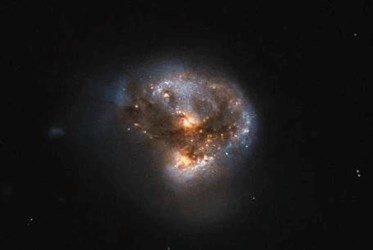Hubble Spots Twin-Core Galaxy Hosting A Microwave-Emitting "Megamaser"
By Jof Enriquez,
Follow me on Twitter @jofenriq

The Hubble Space Telescope's latest impressive image of deep space is that of an unusual galaxy that hosts a megamaser – "astronomical lasers" that emit intense microwave radiation instead of visible light. (Hence the ‘m’ replacing the ‘l’ in microwave amplification by stimulated emission of radiation, or maser).
The nucleus of galaxies often ejects jets of rapidly moving charged particles that radiate brightly at many wavelengths, in particular radio wavelengths. In the case of the galaxy called IRAS 16399-0937, which is 370 million light-years away from Earth, there are two separate but merging nuclei, over 11,000 light-years apart from each other, that radiate these powerful microwaves.
The northern core, IRAS 16399N, is what astronomers call a LINER nucleus (Low Ionization Nuclear Emission Region), which is a region whose emission mostly stems from weakly-ionized or neutral atoms of particular gases. It also hosts a black hole that is 100 million times more massive than the Sun. In comparison, the powerful black hole Sagittarius A* at the center of the Milky Way galaxy is only 4 times as massive as the Sun. The more active southern core, on the other hand, is a "starburst region," birthing many new stars at a high rate.
The twin cores "are both buried deep within the same swirl of cosmic gas and dust and are interacting, giving the galaxy its peculiar structure," according to a NASA/European Space Agency news release. The unique structure and conditions inside this galaxy are perfect in forming megamasers, which are intensely bright, around 100 million times brighter than regular masers found in galaxies like the Milky Way.
"The super glazing of the megamaser is abetted by internal processes by which stimulated gas amplifies light or microwave radiations even as other components in the system such as stars are not contributing anything to the blazing process," reports Tech Times.
"Microwaves pass into clouds of gas and the molecules in that gas can be stimulated to pump out more microwaves than went in, generating a powerful output of coherent radiation at specific frequencies," explains Seeker.
The striking image of IRAS 16399-0937 is made from observations captured across various wavelengths by two of Hubble’s instruments: the Advanced Camera for Surveys (ACS), and the Near Infrared Camera and Multi-Object Spectrometer (NICMOS).
Installed in 2002, ACS has doubled Hubble’s field of view, and consists of three cameras: the wide field camera, the high-resolution camera, and the solar blind camera. In addition to capturing images of galaxies and other distant objects in the universe, ACS maps the distribution of dark matter and studies the evolution of clusters of galaxies.
NICMOS is Hubble's "heat sensor" and its three cameras are specially designed to see distant objects in the universe as they "shift" into near-infrared wavelengths. The instruments can penetrate the interstellar gas and dust that block visible light. NICMOS provides a window into the electromagnetic spectrum to reveal the nature of the universe.
